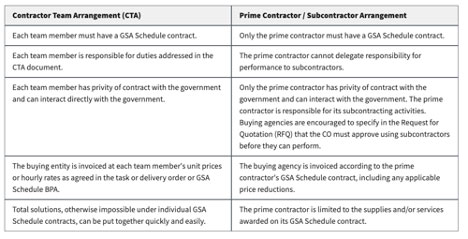Teaming Agreements vs. Prime/Subcontractor Agreements
Prime and subcontractor agreements in the government procurement system are probably more familiar to most people than teaming agreements. With the normal prime and subcontractor relationship, prime contractors work directly with the government. They manage any subcontractors and are responsible for ensuring that the work is completed as defined in the contract.
To become a prime contractor, a business must first register with the System for Award Management (SAM). Federal contracting opportunities are searchable through FedBizOpps, and GSA Schedules. Subcontracting opportunities can be found at the Subcontracting Network database and historical award information that is available in the Federal Procurement Database Systems – Next Generation.
Unlike prime contractors, subcontractors do not work directly with the government but instead work for other contractors. Some government contracts require large companies to subcontract with a small business. This creates more opportunities for small businesses to get involved in federal contracting.
Subcontracting opportunities are posted in the following directories:
- Subcontracting Network database
- General Services Administration’s Subcontracting Directory for Small Businesses
- Department of Defense Subcontracting Opportunity Directory
- SBA’s Directory of Federal Government Prime Contractors with a Subcontracting Plan
Teaming, however, is a different concept. FAR Subpart 9.6 defines a contractor team arrangement as an arrangement where; 1. two or more companies form a partnership or joint venture to act as a potential prime contractor, or 2. a potential prime contractor agrees with one or more other companies to have them act as its subcontractor under a specified Government contract or acquisition program. The latter, in essence, is an agreement to develop a contractor subcontractor agreement for the specific acquisition, once awarded.
GSA contractor teaming arrangements provide yet another teaming opportunity. There the contractor teaming agreement (CTA) allows contractors to use their GSA schedule to develop a solution for the government and does not create a separate legal entity but allows Schedule contractors to meet buyer’s requirements by combining supplies and services from each team member’s separate Schedule contract in response to a buyer’s Request for Quote.
More differences between GSA CTA’s and prime and subcontractor arrangements are detailed below:
